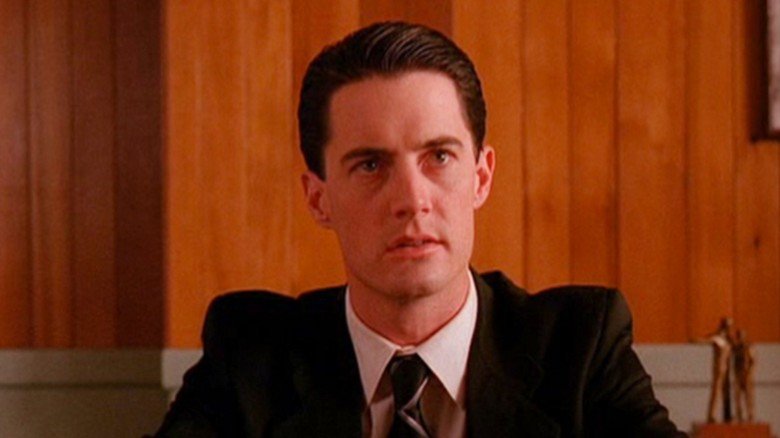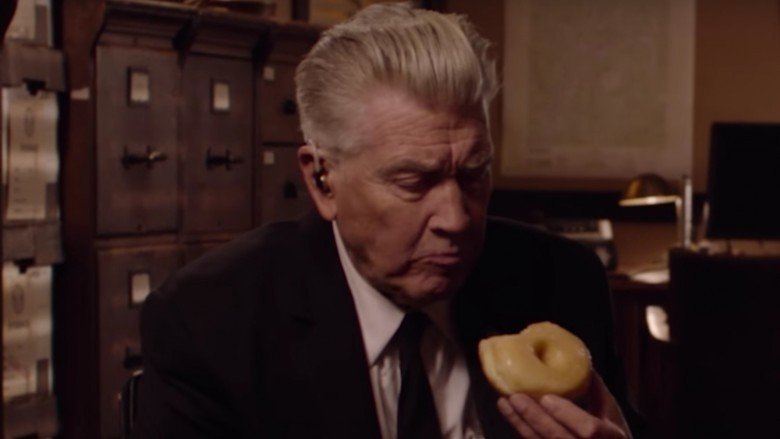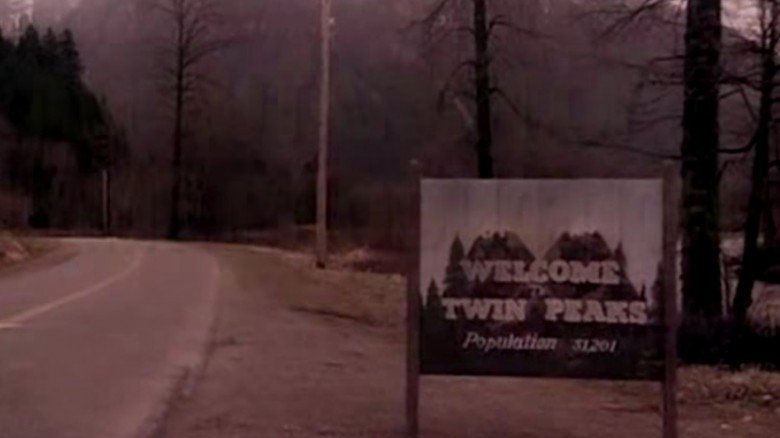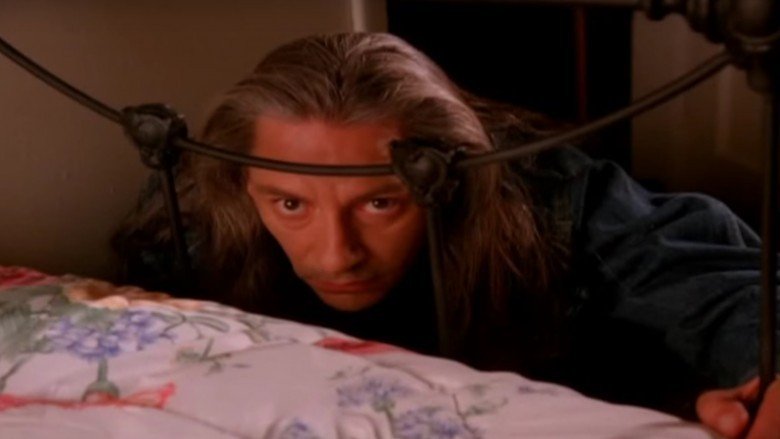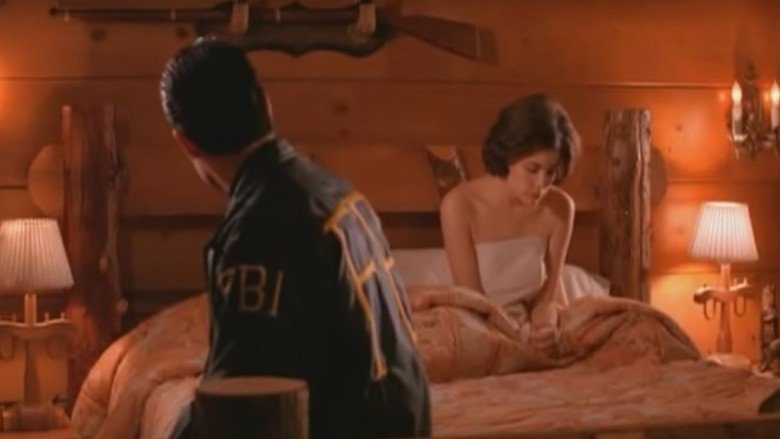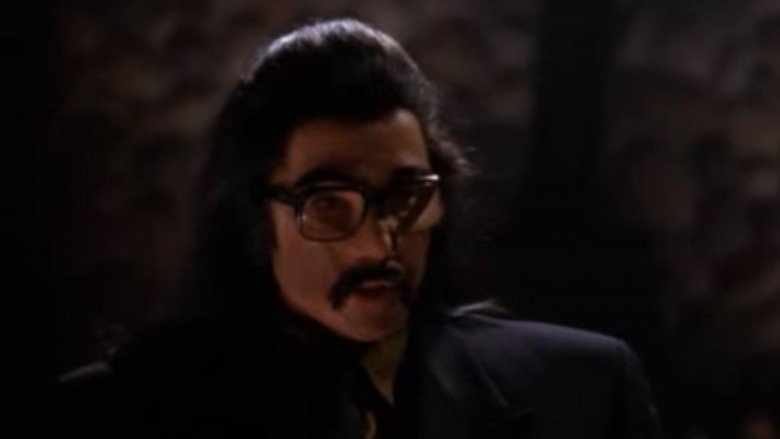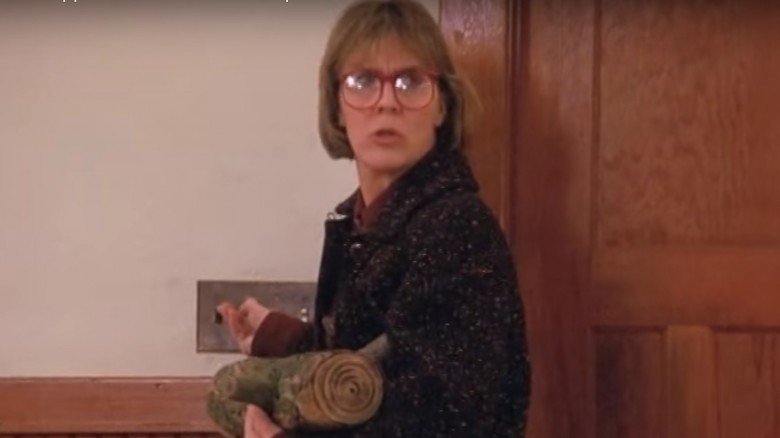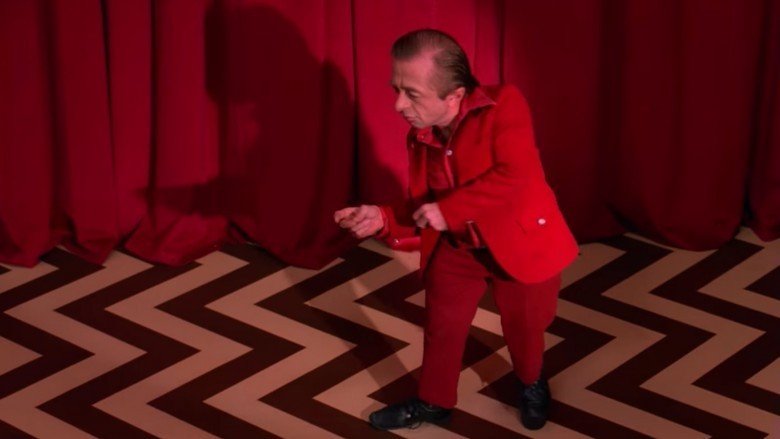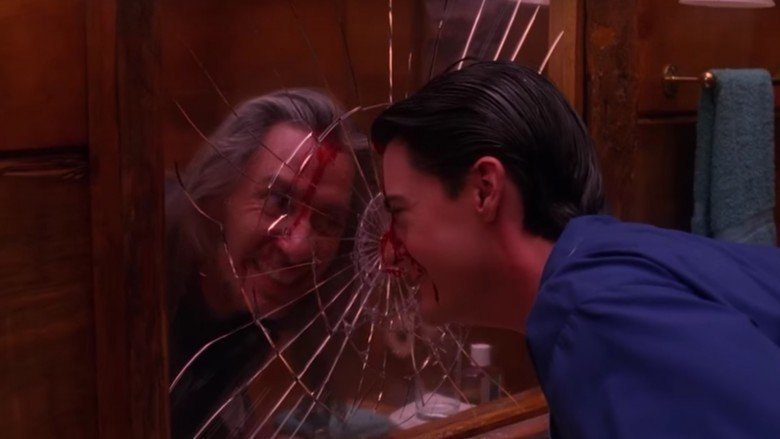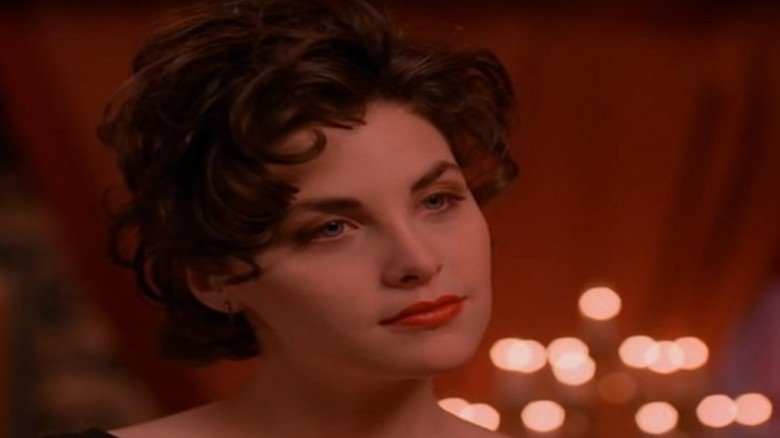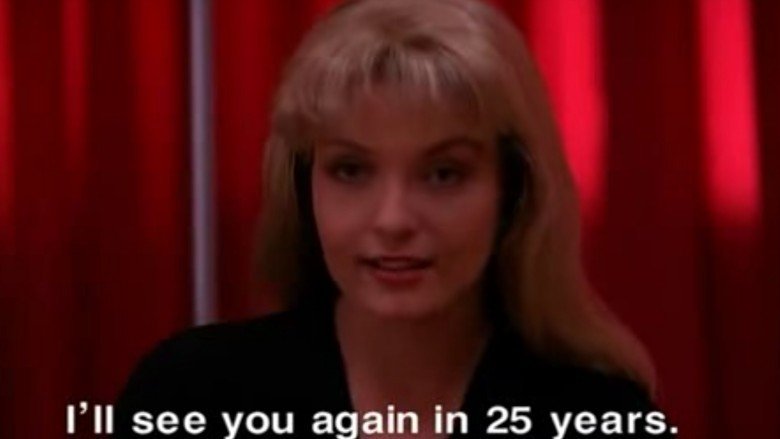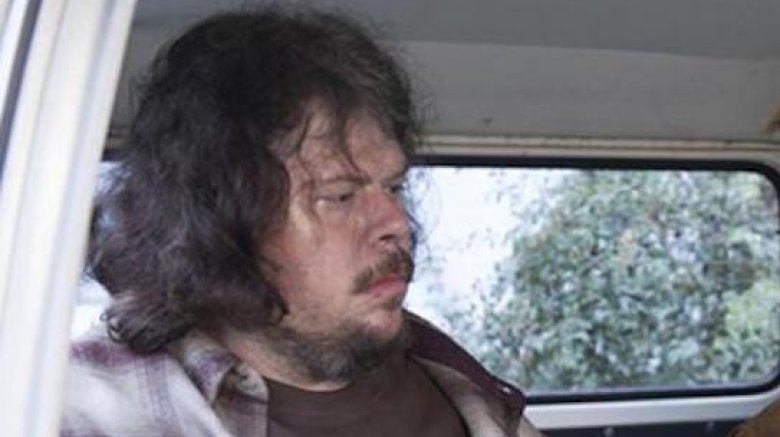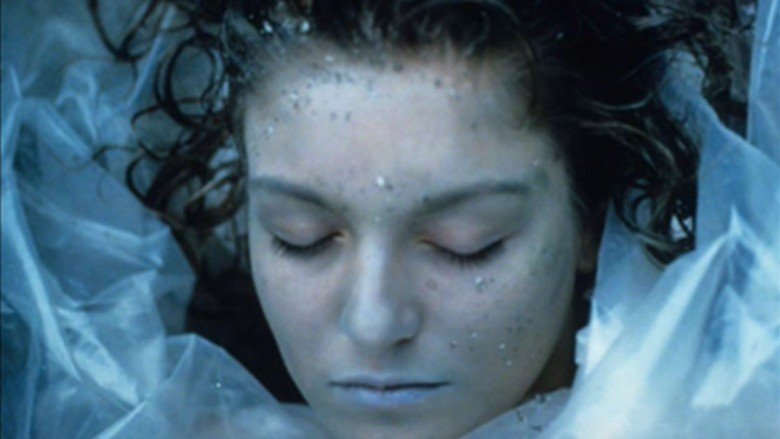The Untold Truth Of Twin Peaks
From 1990 to 1991, TV viewers were obsessed with a tantalizing question: "Who killed Laura Palmer?" That was the central mystery on Twin Peaks, a stylish, bizarre, dreamlike Pacific Northwest-set murder mystery with elements of the surreal, supernatural, and just plain weird. Kyle MacLachlan became a star as Agent Dale Cooper, investigating the murder and exploring the tiny town of Twin Peaks, Washington, and the quirky characters that inhabit it, such as Ben Horne, Shelly Johnson, the Log Lady, and Sheriff Harry Truman. Created by cult film icon David Lynch and Hill Street Blues writer Mark Frost, Twin Peaks was like nothing that had ever been on TV to that point, and it amassed an obsessive following. The show returned to Showtime in 2017, so step into the Red Room, pour yourself a cup of coffee, and have a look into the seedy underbelly of Twin Peaks.
David Lynch was inspired by Marilyn Monroe (and the forest)
In the late '80s, Warner Bros. asked David Lynch to direct a Marilyn Monroe biopic based on Goddess, Anthony Summers' 1985 biography of Monroe. Lynch teamed up with Mark Frost to write the screenplay, but the studio pulled out for what Lynch called "political reasons"—he and Frost followed the long-held conspiracy theory that Monroe didn't die of a drug overdose, but was murdered because her affairs with John F. Kennedy and Robert Kennedy. But Lynch and Frost so liked working together that they began collaborating on other projects. One was a TV series idea called North Dakota set in, well, the plains of North Dakota. While they set out to make a show about "a place far away from the world," they opted to change the setting to the Pacific Northwest because the tree-rich region provided a "sense of mystery in the forest and the darkness." Nevertheless, the idea that Monroe's death was not quite what it seemed definitely factored in to what ultimately became Twin Peaks, with the difficult-to-solve murder of Laura Palmer.
Monroe and the Kennedys even warrant a mention in Agent Cooper's monologue in the second episode of the series: "There are two things that continue to trouble me, and I'm speaking now not only as an agent of the bureau but also as a human being. What really went on between Marilyn Monroe and the Kennedys, and who really pulled the trigger on JFK."
The town population sign is wrong
In the opening credits of Twin Peaks, the fictional town is said to have a population of 51,201. But creators Lynch and Frost wanted the town to be even smaller, with a listed population of 5,120. ABC nixed that, reasoning that people wouldn't tune in to a show about a rural town that was so tiny. The producers made them add the "1" to the end to multiply the population tenfold. But the town of Twin Peaks certainly kept its very small town vibe, and Lynch and Frost playfully got around ABC's order to change the population. In the 1991 tie-in book Twin Peaks: Access Guide to the Town, they wrote that Twin Peaks "recently discovered our population is not 51,201. The 1990 census revealed our present population is 5,120.1, not 51,201."
The character of BOB was a last-minute addition
Frank Silva portrayed BOB, a monster that possesses people and makes them do horrible things. Silva wasn't originally supposed to be in the cast, because BOB wasn't initially even a character. Silva was the Twin Peaks set dresser. While shooting a scene for the pilot from the point of view of Laura Palmer's mother (Grace Zabriskie) standing in the hallway looking into her daughter's room the morning after her disappearance, Silva was in the room putting finishing touches on the set. Director David Lynch realized that if he were to shoot the scene at that moment, Silva would accidentally appear in the frame. "And then suddenly he said, 'Wait a minute! Frank, get down to the base of the bed, crouch down, look through those wrought iron bars, and act scared!'" Silva recalls. "And then they shot the POV, with me at the base of the bed. And it just sort of snowballed from there."
Why the Agent Cooper-Audrey Horne relationship died
The first season of the show featured a budding romance between visiting murder investigator Agent Dale Cooper (Kyle MacLachlan) and Audrey Horne (Sherilyn Fenn). But then that plot thread was abruptly dropped. Reportedly, MacLachlan asked Lynch to break them up because he didn't think a straight-laced guy like Cooper would date a high school student. But according to Fenn, the real reason was on-set tension. At the time, MacLachlan was dating cast member Lara Flynn Boyle, and she and Fenn did not get along. Boyle apparently resented the screen time that Fenn was getting as the romantic interest of the show's main character, and she had MacLachlan approach Lynch.
The truth about Mr. Tojamura
In the first season finale of Twin Peaks, Leo, acting at the behest of Ben Horne, sets fire to Catherine Martell's Packard Sawmill...and Catherine is believed to have died in the blaze. Instead, Catherine survives and plots to destroy Ben Horne and his business by buying up shares under the guise of a Japanese businessman named Mr. Tojamura. But the Twin Peaks writers didn't want fans of the show, or even the cast and crew, to know what was going to transpire. So Piper Laurie, the actress who played Catherine, showed up on set each day ready to play Mr. Tojamura, wearing a suit and several layers of prosthetics and makeup. As Laurie relates in her memoir Learning to Live Out Loud, cast and crew were told that this person was a legendary Japanese actor named Fumio Yamaguchi, and that he didn't speak much English.
Meanwhile, Twin Peaks insiders and fans alike assumed Catherine was dead because Piper Laurie's name had been taken out of the credits. But a few still thought something was up. Cast member Peggy Lipton (Norma) thought the Japanese actor wandering silently around the set was actually a disguised Isabella Rossellini, who had dated David Lynch around the time Twin Peaks was in production.
David Lynch conceived of the Log Lady in the '70s
One of the quirkiest characters on Twin Peaks, a show loaded with quirky characters, was the Log Lady. Portrayed by Catherine Coulson, she only could've existed on Twin Peaks. Surprisingly, David Lynch came up with the Log Lady in the late '70s, years before he co-created Twin Peaks. He had the idea on the set of his cult classic Eraserhead, the night they were filming the pencil eraser-making scene. Coulson says that Lynch "was always very fond of wood because his father was a research botanist for the U.S. Forest Service." Seeing Coulson in her glasses, and with wood apparently on his mind, Lynch told Coulson that he wanted to make a TV series starring her some day called I'll Test My Log with Every Branch of Knowledge. "And the idea was that Catherine would go with the log to various experts; a dentist, a doctor, a physicist. And they would talk only to the log and we would learn that information as an audience."
Twin Peaks fever was a worldwide phenomenon
Aaron Spelling Productions is responsible for some huge TV hits, such as Charlie's Angels, Melrose Place, and Twin Peaks. When the latter was on the air, Spelling Productions was half-owned by a powerful financier named Carl Lindner. During the show's first season, Aaron Spelling himself received a call from Lindner demanding to know who killed Laura Palmer. Spelling didn't know, so he passed off the matter to Spelling Productions president Jules Haimovitz, who asked David Lynch directly. Lynch wouldn't reveal the answer. Haimovitz reported the non-information back to Spelling, along with a query as to why this was all so important. Turns out, it was because Lindner was asking about the central mystery of Twin Peaks on behalf of President George Bush, a friend whose campaign he had helped fund. But Bush didn't really care about Laura Palmer—he was calling to ask for his friend: Mikael Gorbachev, president of the Soviet Union.
The show was spoiled for German viewers
The second (and at the time, final) season of Twin Peaks concluded on American airwaves in June 1991. The series didn't debut in Germany until September 1991; it takes time to dub or subtitle more than two dozen episodes of a TV show, after all. Airing in Germany on the network RTL plus on Friday nights, the series was pulled off the air before every episode could be shown. The reason: low ratings. The reason for the low ratings: in a fit of corporate sabotage, a rival network revealed who killed Laura Palmer early. A network called Sat 1 stated the identity of Laura Palmer's murderer in a news segment, as well as the motive.
There was almost an Audrey Horne movie
After the show had been on the air for a while and all of its characters had been established, Audrey Horne emerged as a fan favorite. (Or perhaps it was the actress who portrayed the plucky high school student, Sherilyn Fenn.) David Lynch and Mark Frost proposed a Twin Peaks spin-off feature film to Fenn, centered around her character moving to California. "They talked about an opening scene of her driving along Mulholland Drive, and how she's a little bit older. Whatever it was going to be, it never ended up happening for me." It didn't happen for her, but it sure happened to someone else. The idea of a young woman getting into bizarre adventures in Southern California is pretty much what Naomi Watts' character does in the 2001 movie Mulholland Drive, directed by David Lynch.
There were other revival attempts
The last episode of the original run of Twin Peaks features Sheryl Lee (as some kind of spectral Laura Palmer, probably) telling Agent Cooper that she'll see him again "in 25 years." The Twin Peaks revival aired on Showtime in 2017—which marks 26 years since the series went off the air, so they were only off by a year. The revival was first announced nearly three years earlier, with an air date of 2016. But that's not a long time to wait, in the grand scheme of botched Twin Peaks continuation attempts. In 1993, the cable network Bravo secured the rights to air reruns of the show, and persuaded David Lynch to write and direct new introductions to the episodes.
As part of a deluxe DVD release of the full series in 2007, Twin Peaks story editor Bob Engels teamed up with comic artist Matt Haley to create a real, canonical, and complete third season of the show in graphic novel format. Co-creator Mark Frost liked the idea, and Engels provided all the notes he still had on where the third season was supposed to go, which was to be set 10 years after the events of season two. Among the plot points: Dale Cooper had quit the FBI and moved to Twin Peaks to work as the town pharmacist, and BOB was going to kill another character played by Sheryl Lee (who played both Maddy and Laura Palmer). Engels and Haley even tossed around an idea of BOB being from "a planet made of creamed corn." The graphic novel was ultimately never finished because David Lynch refused to sign off on it.
A bit player was arrested for a terrible assault
Sadly, the darkness, weirdness, and violence explored on Twin Peaks and Twin Peaks: The Return isn't restricted to the screen. Jeremy Lindholm, who played Mickey in the "Part 6" episode of Twin Peaks: The Return, was arrested by police in Spokane, Washington in August 2017. Lindholm was charged with attempted second degree murder after he allegedly beat a woman, reportedly his girlfriend, with a baseball bat. After he cut out a back door of the 420 Lingerie Boutique with the bat in hand, officers caught up to him in an alley and he surrendered. According to Spokane newspaper The Spokesman-Review, LIndholm told police that he angrily followed the woman to her place of employment because he was upset she didn't buy him any Kool-Aid before she left for work.
David Lynch never wanted to say who killed Laura Palmer
Despite Twin Peaks being, at its core, a murder mystery, the creators never wanted to actually reveal the identity of Laura Palmer's murderer. "It was not supposed to get solved," Lynch says. "The idea was for it to recede a bit into the background, and the foreground would be that week's show. But the mystery of the death of Laura Palmer would stay alive." That simply would not do for ABC executives, who urged Lynch and Frost to finger the murderer at the end of the first season.
They didn't, ending the first batch of eight episodes with multiple unresolved storylines. (The writers even sent the network a fake finale script to indicate that they were playing along.) That, along with the show's huge ratings, ensured a season two renewal...and more pressure from ABC to say who killed Laura Palmer. In the middle of season 2, viewers finally learned that (spoiler alert) Laura had been killed by her father, Leland Palmer (Ray Wise), while he was possessed by BOB. With that knowledge out there, ratings for the show dropped—by February 1991, the once top-30 hit finished #85 out of 89 shows for the week. Soon thereafter, Twin Peaks was canceled.
